### Teal, Bob: (page created for november 2007 update)
## Bob Teal – Magnipulsion, by Energetic Science Ministries from http://www.esmhome.org/library/bob-teal/index.html
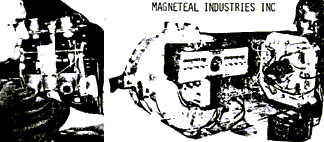
“Laying dormant within the modern electric motor is a deep, dark secret. For the last 176 years, that secret has held the electric motor to its present level of performance. But in 1975, a quantum leap in electric motor design was made by an American inventor named Bob Teal. Teal’s Magnipulsion Engine produced COPs between 8 and 10.”
10min 5sec – 54.1mb – wmv video format(RIGHT CLICK ON THE LINK AND SELECT – SAVE TARGET AS AND SELECT DOWNLOAD LOCATION)
BOB TEAL MISSING INTERVIEW VIDEO DOWNLOAD http://www.esmhome.org/library/bob-teal/bob-teal.wmv
or watch below in Youtube http://www.youtube.com/v/qU5LkEXkFjU
or Google Video http://video.google.com/googleplayer.swf?docld=5788002385345479
# Bob Teal – Magnipulsion Information & Resources
– ELECTRIC MOTOR SECRETS http://www.free-energy.ws/products.html by Dr. Peter Lindemann. Revealing all of Bob Teal’s Secrets (2.5 hours DVD)
– Dr. Peter Lindemann Interview by Sterling D. Allen of Free Energy Now http://pesn.com/Radio/Free_Energy_Now/ Radio Show. Thanks to Mr. Allen for supporting these technologies!
– Electric Motor Secrets Interview http://www.esmhome.org/library/bob-teal/electric-motor-secrets.mp3 (right click to save)
– Bob Teal http://www.free-energy.ws/bob-teal.html information page. (MDG nov07: see extracts below on this page)
– Electric Motor Secrets http://www.energeticforum.com/renewable-energy/271-electric-motor-secrets.html Official Discussion Forum
– “Impossible” Engine Invented for Real”, LA Times, May 30, 1976. If anyone has a copy of this article, a copy would be apprecaited.
Please post a message here: Bob Teal – Magnipulsion http://www.energeticforum.com/renewable-energy/190-bob-teal-missing-interview-finally-surfaces-after-decades-searching.html
ARTICLE FOUND!!! Thanks to someone who made contact from the information recently released about Bob Teal, someone came forth with the LA Times article. Impossible Engine Invented For Real http://www.esmhome.org/library/bob-teal/bob_teal_la_times.pdf (MDG nov07: see transcription below on this html page)
– USP #4,024,421 http://www.free-energy.ws/pdf/Teal4024421.pdf – Magnetically Operable Engine or Power Plant – PDF
– USP #4,093,880 http://www.free-energy.ws/pdf/Teal4093880.pdf – Magnetically Operable Engine – PDF
– Magneteal Industries http://www.free-energy.ws/pdf/Teal-MagneTeal.pdf , Inc. Company Literature. (MDG nov07: see transcription below on this html page)
– Newspaper Articles http://www.free-energy.ws/pdf/TealNews.pdf (MDG nov07: see transcription below on this html page)
## BOB TEAL, Benjamin Robert Teal from http://www.free-energy.ws/bob-teal.html
Bob Teal was born in Morven, North Carolina in 1922. He attended Wofford College in Spartanburg, South Carolina and the University of Hawaii, in Honolulu. Upon graduation, he joined the Coast Guard, and enjoyed a 20 year career that ended in 1962. Sometime after the end of WW2, he married his wife Beatrice and they raised two children. After leaving the Coast Guard, he worked as an electronics engineer for a number of companies including Ling Temco Vought, RCA, and finally as a civilian employee of the US Air Force. He retired at the age of 50 in 1972.
A few years before retiring, he wrote a Science Fiction Novel that was never published. It included an invention by the main character that was an electro-magnetic engine that produced no noise or pollution. He named it “Magnipulsion”.
After retirement in 1972, Bob and Beatrice moved from Honolulu to Madison, Florida. Like many creative people, “retirement” didn’t agree with him. With nothing else to do, he decided to build a model of the sci-fi engine he had invented for his novel. It worked! The Magnipulsion Engine produced large amounts of mechanical energy while running on small pulses of DC current to its electro-magnetic coils. In addition, when the power coils were turned off, the circuitry could also recapture most of this input electricity from the collapsing magnetic fields to recharge his batteries or run other loads. It was a quantum leap in electric motor design.
Bob Teal formed Magneteal Industries, Inc. and tried to raise capital to develop the invention. Ultimately, only a handful of friends and small investors ever bought in. Most of these funds were used to build the 6 working prototypes and file the two US Patents that issued in 1977 and 1978. The last prototype was able to produce 1 horsepower and could run a 20-ton conveyor belt on the same automotive battery for months.
He tried to interest officials in the State and Federal governments, but was unsuccessful. Dozens of newspaper stories were written about Bob Teal and his Magnipulsion Engine between 1976 and 1978. The biggest story that ever ran was the one in the LA Times on May 30, 1976 titled “Impossible” Engine Invented for Real. While the publicity brought hundreds of inquiries, nothing ever came of all the interest. The motor’s performance was just too “unbelievable” for most engineers and scientists who observed its operation.
Out of money, and frustrated that he could not interest Government officials or a major investor, Teal retired again and the story of the Magnipulsion Engine faded into history.
The following links lead to additional information on Bob Teal and the Magnipulsion Engine:
# PATENTS :
– USP #4,024,421 http://www.free-energy.ws/pdf/Teal4024421.pdf – Magnetically Operable Engine or Power Plant
– USP #4,093,880 http://www.free-energy.ws/pdf/Teal4093880.pdf – Magnetically Operable Engine
# ARTICLES :
– Magneteal Industries, Inc. Company Literature http://www.free-energy.ws/pdf/Teal-MagneTeal.pdf
– Newspaper Articles http://www.free-energy.ws/pdf/TealNews.pdf
# LINKS :
– View the missing Bob Teal Interview http://www.esmhome.org/library/bob-teal/index.html
– Purchase the DVD that explains Bob Teal’s Magnipulsion Engine, Electric Motor Secrets http://www.free-energy.ws/products.html
## Los Angeles Times, Sunday May 30, 1976, BOB TEAL, transcription by MDG nov07, from http://www.esmhome.org/library/bob-teal/bob_teal_la_times.pdf
‘Impossible’ Engine Invented for Real
MADISON, Fla. (UPI) – Writing a science fiction novel for his own amusement eight years ago, Bob Teal dreamed up an ‘impossible machine’. Today it’s working in a shed in his yard.
The 53 year old retired electronics engineer has invented a motor run by electromagnets. He calls it a ‘magnepulsion engine’ and believes it could set the world of propulsion on its ear.
‘The first reaction of everyone is : Hey, it can’t work,’ Teal said. ‘But here it is, and it works. You’ve got to see it to believe it.’
Teal flicks the switch. Pulsating direct current electricity from a small motorcycle battery travels through his secret timing device to six electromagnets, only an inch in diameter.
The magnets, in turn, start a 75 pound flywheel whirring. The working model of Teal’s magne-pulsation engine can spin the flywheel at a maximum of 800 revolutions per minute. He doesn’t have the equipment to measure its horse-power but says ‘if you try to hold the crankshaft it’ll tear up your hand’.
To demonstrate its usefulness, Teal has his 100 pound machine hooked up to run a table saw. Teal’s invention requires no fuel, emits no gasses and is very quiet in operation. It has few moving parts and needs little maintenance.
Teal’s model is a crude piece of eauipment held together by a wooden frame of two by fours and two by sixes.
‘You should have seen my first model which worked’, Teal chortled. ‘It had wooden shafts, wooden rods and wooden bearings. I powered it with a flashlight battery’.
He makes a ‘way out guess’ his engine could be mass produced to propel automobiles at a cost of about USD 300 to 400 per unit. It also could be adapted to run airplanes, boats, power plants, and many other devices, he said.
Discussion at: http://www.energeticforum.com/renewable-energy/271-electric-motor-secrets.html
## The Magnipulsion Engine, tomorrow’s energy today, Magneteal Industries Inc., transcription by MDG nov07, from 10 pages document : http://www.free-energy.ws/pdf/Teal-MagneTeal.pdf
Magneteal Industries Inc.,611 West Marion Street, Madison, Florida 32240.
‘There is nothing as powerful as an idea whose time has come’ (Voltaire)
# Preface: The national energy crisis automatically places the magnipulsion engine in the spotlight. The demand for energy, not only in the United States of America, but around the world, is such that an emergency situation exists.
Left open to a free market there is an unlimited demand for manipulsion energy. As soon as it is made available to the world, the demand will be instantaneous.
Magnipulsion energy means that every home may have it’s own power plant, every machine shop may have it’s own power plant, and most industries and businesses may have their own generating plants.
Magnipulsion means that consumer costs of running small and large appliances can be cut to a small fraction of the present costs of running these appliances. Magnipulsion means the dawn of a neew era where there will be less waste of energy, time and dollars.
Due to the simplicity of construction of the manipulsion engine, assembly line production would be only a small fractionas complex and costly as the present production of internal combustion engines and electric motors.
The fact that no one to date has advanced electro-magnetic research to the point of efficient and practical application does not mean that magnipulsion should be condemned as something that will not work, because the workability and feasability of electro magnets has been fully proven in the shop of B. Robert Teal in Madison, Florida.
It is the hope that American industry will react favorably to magnipulsion, and we will not have to resort to foreign markets as did Bill Bokon who finally, after American industry refused to acknolewdge his ‘Vapor-dyne’ motor (which is a vast improvement over internal combustion engines now being produced in America) finally sold his engine to Indonesia. At the present time buyers are being sought for the magnipulsion engine.
To all mankind should be brought to light the apathy of a materialistic society which curtails progress and truth by it’s failure to promote that which is for the benefit of all. When the public good is involved, established business procedures should be pre-empted by new policies which would acknowledge and accept new technological break-throughs. MAGNIPULSION energy is a prime example.
# MAGNIPULSION —– TOMORROW’S ENERGY TODAY
1 – WHAT IS THE ‘MAGNIPULSION’ ENGINE ?
An engine that is motivated by electro-magnets which serve in a manner similar to pistons in an internal combustion engine. It receives it’s (initial) power from a car battery. There is a continuous charge of energy without any supplementary source other than the battery. The capabilities of the manipulsion engine are relatively unlimited. We know it can power automobiles, air conditioners, home power plants, machinery or anything which utilizes fossil fuels or electric motor drives.
2 – WHY HASN’T THIS INEXPENSIVE, PRACTICAL AND POWERFUL ENERGY CONCEPT BEEN DISCOVERED BEFORE THIS ?
The field of magnetics has not been explored comprehensively by the scientific community. What has been done in this field before the arrival of the magnipulsion engine has been spasmodic. To the inventor of magnipulsion these forerunners missed the mark considerably by not harnessing the principles now patented in the magnipulsion engine.
3 – DOES IT TAKE A GRADUAL BUILD-UP OF ENERGY BEFORE MAXIMUM LOAD CAN BE UTILIZED ?
The magnipulsion engine will start and reach maximum RPMs almost instantly. No hesitation will be noted under normal load.
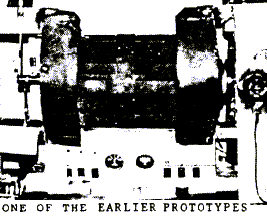
4 – WHAT PROOF HAS BEEN ESTABLISHED AS TO THE EFFICACY OF THE MAGNIPULSION ENGINE ?
Witnesses have observed the magnipulsion engine turning a 20 TON conveyer, alternators, generators, bench saws, and other general purpose applications.
5 – CAN TESTS BE RUN ON THIS ENGINE TO PROVE IT’S EFFICIENCY ON MACHINERY AND EQUIPMENT SUPPLIED BY EN INTERESTED BUYER ?
Certainly. All potential nuyers (users) of this inexpensive and effective power source are welcome to make an appointment for this purpose.
6 – WHEN CAN MANIPULSION ENERGY BE USED FOR THE BENEFIT OF INDUSTRY AND ALL MANKIND ?
As soon as the purchasers make their appearance to test the manipulsion engine and negociate for it’s license or purchase.
7 – HOW DOES MAGNIPULSION COMPARE TO CURRENT STANDARD ENGINE CONCEPTS ?
The magnipulsion engine may be described as superior to any other engine concept known to the inventor, including the present internal combustion engine and electrical engines.
8 – WHAT WILL MAGNIPUSLION DO FOR ME ?
Provide mechanical energy for your needs at a fraction of the cost you are now paying.
9 – WHAT IS THE COST OF THE MAGNIPULSION ENGINE ?
Initial equipment cost will be about 50% of internal combustion engines with ‘fuel’ costs but a fraction of what you are now paying.
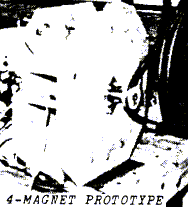
10 – HOW MUCH HORSEPOWER DOES MAGNIPULSION GENERATE ?
The maximum horsepower has not been determined but it appears to be unlimited.
11 – HOW MUCH DOES IT COST TO RUN ?
EXAMPLE: A 10 horsepower magnipulsion engine would cost pennies a day or a small fraction of what conventional engines cost.
12 – HOW MUCH MAINTENANCE DOES MAGNIPULSION REQUIRE ?
With a minimum of moving parts there is negligible wear; hence minimum maintenance.
13 – WHAT IS THE EXPECTED LIFE OF THE MAGNIPULSION ENGINE ?
Unlike internal combustion engines and electrical motors which have many wear factors, the MAGNIPULSION engine has few, so with replacement of minor parts, the engine could continue to run effectively indefinitely.
14 – WHERE CAN A DEMONSTRATION BE WITNESSED ?
Appointments can be made by writing to 611 West Marion Street, Madison, Florida 32340.
15 – CAN I BRING MY ENGINEERS TO DISCUSS BUSINESS WITH YOUR COMPANY ?
Yes, prospective buyers and their engineering staff are welcome but they must be prepared to see and learn of a new and revolutionary discovery which some in the scientific community consider contrary to established laws of physics and/or electro-dynamics.
16 – HOW LONG WILL IT TAKE BEFORE I RECEIVE MY FIRST ORDER FOR MAGNIPULSION ENGINES ?
When production commences it will depend on the engineering that has to be performed to prepare the engine for your specific needs (generally, three months to a year).
17 – WHAT HAS ESTABLISHED BUSINESS IN THE ENERGY FIELD BEEN DOING ALL THIS TIME ? WHY HADN’T THEY CONCEIVED OF THIS PRINCIPLE BEFORE ?
The power giants have been paying closer attention to their present source of profits. i.e. maintaining their monopolies with controlled technologies, ignoring less expensive power sources, and limiting their research to more or less established fields.
18 – WHAT USES AND APPLICATIONS APPLY TO THE MAGNIPULSION ENGINE ?
Truly they are relatively unlimited. Magnipulsion engines can be substituted for any electric motor or internal combustion engine at a fraction of their cost. (Examples: automobiles, machinery, air conditioners, elevators, golf carts, motor cycles, aircraft, lawn mowers, irrigation systems, motor boats, etc… .
19 – CAN I LICENSE THE MAGNIPULSION ENGINE ON AN EXCLUSIVE BASIS TO MARKET MY PRODUCT LINE TO THE TRADE I SERVE ?
Yes. Exclusive licensing agreements will be granted under certain circumstances.
20 – WHAT KIND OF PERSONEL WOULD BE REQUIRED TO SERVICE THE MAGNIPULSION ENGINE ?
No specialized training is required.
21 – COMPARED TO PARTS REPLACEMENT ON INTERNAL COMBUSTION ENGINES AND ELECTRIC MOTORS, WHAT MIGHT ONE EXPECT IN WAY OF PARTS REPLACEMENT FOR THE MAGNIPULSION ENGINE ?
Compared to parts replacement needs of the internal combustion engine and electric motors, the magnipulsion engine requires but a small percentage of the former.
22 – HOW CAN WE NEGOCIATE TO ACQUIRE RIGHTS TO MANUFACTURE THE MAGNIPULSION ENGINE ?
Negociations can take place as soon as we agree to a time and place of meeting.
23 – ARE RIGHTS TO THE EXPORT MARKET AVAILABLE TO A FIRM WHICH HAS A PROVEN RECORD OF OVERSEAS BUSINESS ?
Yes, there is a great need for the magnipulsion engine around the world, especially in the undeveloped countries where capital is scare and there exists a great need for economic growth or recovery (which the magnipulsion engine can surely provide if the nation accepts it without strings and prohibits the interference of vested interests.
24 – WHAT IS THE MAIN DIFFERENCE BETWEEN MAGNIPULSION AND OTHER ENGINES WHICH USE ELECTRICITY TO POWER MACHINERY, ETC… ?
Unlike electrical motors which take a continuous supply of electric power, the magnipulsion engines runs continuously on relatively minute quantities of pulsating current.
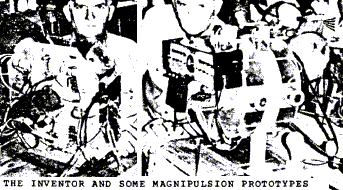
25 – HOW MUCH ENERGY IS WASTED WITH THE MAGNIPULSION ENGINE ?
Negligible. Insignificant heat loss, few moving parts, and minimum wear mean very little loss of energy, greater efficiency of performance, and longer life.
26 – DOES THE BATTERY WEAR OUT QUICKLY OR QUICKER THAN WHEN USED CONCENTIONALLY ?
No. There is little stress placed on the battery because it does not draw from this source continuously but rather utilizes short duration pulses.
27 – WHAT ARE THE MAINTENANCE COSTS OF THE MAGNIPULSION ENGINE ?
An occasional replaced magnet, wiring or battery. These costs must be considered negligible.
28 – WHAT IS THE COST (ROUGHLY) OF A MAGNIPULSION ENGINE CAPABLE OF 50 HORSEPOWER ? 100 HORSEPOWER ? 200 HORSEPOWER ? 300 HORSEPOWER ? 400 HORSEPOWER ?
We estimate (mass production) the cost of a 50 horsepower magnipulsion engine to be about USD 450.00, a 100 horsepower engine about USD 700.00, a 200 horsepower angine about USD 1,000.00 and a 500 horsepower engine about USD 1,700.00. Of course we hope to see these prices eben lower.
29 – DOES THE ENGINE EMIT ANY POLLUTANT ?
No, the engine is pollution-free.
30 – IS THERE ANY NOISE TO THE ENGINE WHEN IN OPERATION ?
Negligible.
31 – IS THERE ANY REASON TO BELIEVE THAT THE MAGNIPULSION ENGINE IS INCAPABLE OF TAKING OVER FOR THE INTERNAL COMBUSTION ENGINE AND PRESENT ELECTRICALLY-POWERED MOTORS ?
The principle proving the utilization of energy from magnets has been fully and completely proven in our shop. Magnipulsion is convertible into relatively unlimited horsepower and therefore can be used wherever these other power sources are currently used.
32 – DOES THE ENGINE REQUIRE OXYGEN SUCH AS THE INTERNAL COMBUSTION ENIGNE ?
No. Also, it should operate at any altitude.
33 – WHAT IS THE WEIGHT OF THE MAGNIPULSION ENGINE ?
It is but a fraction of the weight of the internal combustion engine.
34 – WHAT IS THE EXTENT OF THE MARKET FOR MAGNIPULSION ?
The market for the magnipulsion engine should be unlimited if the combined political-industrial complex is willing to phase from obsoleted fossil fuel and the present electrical energy devices.
35 – WHAT IS THE STATUS OF THE SECOND PATENT APPLICATION ?
We are in receipt of a patent filing number.
36 – WHAT ARE YOUR PLANS TO PUBLICIZE INFORMATION ON THE MAGNIPULSION ENGINE ?
There have been many newspapers and some magazines, and the quantity of mail we have received, we believe that at least several hundred thousand have heard of the magnipulsion engine.
38 – HAS THERE BEEN ANY RESPONSE FROM THE OFFICE OF THE PRESIDENT OF THE UNITED STATES OR GOVERNMENT OFFICIALS ?
No, except for some individual legislator’s encouragement.
39 – WHAT IS THE GREATEST NEED RIGHT NOW ?
Working capital, and individuals and groups friendly to our cause who are willing to contribute of their time, talents and resources.
See many pictures on page 9, ‘Shop Shots’. (but very low quality pictures as above)
Benjamin Robert TEAL: Born in 1922, Bob Teal has long been an idea man … An inventor and an innovator, a type of person that will always say ‘it can be done’, ‘the impossible is a little harder’.
One has only to take a long hard look at history to see that most of the more important inventions came to light amid considerable hostility by members of the scientific community and the establishment.
Bob Teal is Magnipulsion, for many years he has been interested in a field not thoroughly explored by the scientists of our day – ELECTRO-MAGNETICS, Magnipulsion is the energy of tomorrow today.
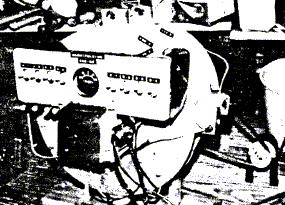
## Magnipulsion is answer to energy crisis, Bob Teal, transcription by MDG nov07, from 10 pages document : http://www.free-energy.ws/pdf/TealNews.pdf
Tallahassee, Madison inventor-writer says his new engine works … but he hasn’t interested Askew or Carter in it yet. By Doris Morgan. Democrat Staff writer.
MADISON = A retired engineer who works in a small shop at his home in Madison says he has invented a machine which might be the answer to the energy crisis. B.R. ‘Bob’ Teal said he got the idea for what he calls his ‘magnipulsion’ engine when he was writing an still-inpublished science fiction novel.
After retiring from an engineering post in Hawaii with Ling Temco Vought in 1972. Teal and his wife Beatrice moved to Madison where he decided to try out his idea. Entering Teal’s backyard workshop, you see two stainless steel contraptions with wires and switches stuck here and there, his latest magnipulsion engines.
After expaining that the thing is started with a car battery, Teal flips several switches which sends current to the magnets placed around the engine. The one horsepower engine which sounds like a sewing machine while operating, is the sixth in a series of electromagnet machines which Teal has developed since he began in 1972.
While the pistons pump up and down, much like a car engine through their magnetic cylinders, the pulleys spin around. Speed is reduced or increased by the flip of a switch that controls the power like the dimming of a light bulb.
‘As it is now the machine can power shop tools, water pumps, or conveyors’, Teal said. ‘You can add horsepower by adding magnets’.
‘I have built six engines and the latest will operate a 20 TON conveyor’, Teal said. He said he bought the car batteries more than a year ago and they have never been charged but once.
Teal says his invention could save coal and oil which are now required to create electricity. ‘A small magnipulsion engine could operate a home central air conditioner for about 50 cents per day’, he said.
Teal has had inquiries from all over the nation about his engine since the wire services carried a story in May 1976. Overflowing files in his home office contain correspondence he says, from private individuals offering money, research and development firms and governments officials who say they are interested in the engine.
However, according to Teal, they want him to come to them and he doesn’t have the money for trips all over the nation. ‘I have invited Carter’s energy people and Governor Askew’s office to come down but I don’t know when they will get here’ Teal said. Georgia developers seem more interested then others, according to Teal.
Teal said one backer from Valdosta, Ga. had offered him a 50,000 square foot building with equipment and financing for his work. While he declined to name the backer, Teal said he planned to take the offer if government officials don’t show interest pretty soon.
I’m out of money and don’t want to sell the engine to some company to be shelved because it is inexpensive to build and operate’, Teal said. This is not the first invention for the retired engineer. While working with RCA under contract for the Navy. Teal invented a device for measuring and stretching radio cable which saved much time and money for the Navy.
Teal explained that the radio operations had previously been down for two or three days when cable repairs were necessary. With his ‘Teal tube’ the radioes could continue operating while the repairs were underway. The inventor proudly displays letters from Navy officials giving him credit for the discovery. How ever, since Teal was under government contract at the time and working with government equipment, the invention belongs to the Navy instead of the individual, be explained.
Teal has patented his new engine and says it would take approximately one year and about USD 350,000 to get the engine onto the market. Horsepower could be increased as the buyers desired, by adding more magnetic pods to the original engine.
The inventor says he invites any one who is doubtful or interested in possibilities of the machine to visit his backyard shop at 611 West Marion Street, where he continues work on the project everyday. ‘Most people won’t believe it until they see it’, he said. This reporter saw it and doesn’t know if she believes it or not.
## Madison Man Builds New Engine, Valdosta Times, front page feature, Georgia, 13 March 1977, by Elizabeth Butler transcription by MDG nov07, from 10 pages document : http://www.free-energy.ws/pdf/TealNews.pdf
Madison, Fla. – The writing of a science fiction book eventually led a Madison resident to invent an electromagnetic engine which he says emits no pollution and takes little current to operate. B.R. ‘Bob’ Teal, a retired electronics engineer and author, has one patent and two pending on his invention.
‘I wrote a science fiction book several years before retiring and I needed the story plausible – an engine that emitted no pollution – noise or air pollution – so in my mind at the time I named it magnipulsion.’
‘Then after retiring in Honolulu in 1972 we came to Madison to live anad having nothing else to do. I decided to build the engine I built and it works’.
Teal, 54, said scientists and engineers have come from all over the country and confirmed that it does what they consider to be impossible.
‘I have built six engines and the latest will operate a 20-ton conveyor’, said Teal, who was born in Morven, N.C., about 60 miles from Charlotte. ‘It operates from a standard car battery and draws an extremely small amount of current. I bought the car batteries over a year ago and they have never been charged but once’.
Teal constructed his first engine of wood within a few weeks to see if it would work. The second engine was a crude one of metal and later he went to Jacksonville to get parts made for a proto-type.
‘I have dreams of building one large enough to run cars and boats’, Teal said. ‘Judging from what I have done so far, I guess it would cost about USD400 or 500. There are very few moving parts so you would not need highly trained mechanics’.
Since the United Press International carried a story of his invention in May, 1976. Teal has received hundreds of letters about the invention from around and the world and has answered all of them. ‘I have been attempting to get the government interested in hopes of getting a grant to build a shop and hire qualified personel’, he said. ‘If I don’t succeed in the very near future in getting the grant, my attorney is preparing to go public and sell stock’.
Teal said telegrams from all over the nation, including Florida, California, Oregon …., from foreign cities, such as Guam, Hong Kong and Tokyo have been sent to President Jimmy Carter asking him to investigate the potential of the engine.
The electromagnetic engine is not the first invention for Teal. While working as a RCA engineer and filling a contract with the Navy in 1964, he was responsible for a classified invention which related to radio frequency cables and was valued at USD50 million. ‘I didn’t get a penny for that,’ said Teal, who has a letter from the Navy Department giving him full credit for the invention. Teal, who attended Wofford College in Spartanburg, S.C., and the University of Hawaii, retired from the Coast Guard after 20 years in 1962. He then worked for Ling Temco Vought, RCA and finally went into Civil Service work with the Air Force, retiring in 1972.
During 1966-76 he wrote a column. ‘Is Justice?’ for the Madison Carrier and last year he published a book of poems. He is married to the former Beatrice Mac Cole of Baltimore, Md, and they have two married children.
## USP 4,024,421, May 17, 1977, Magnetically Operable Engine or Power Plant, Benjiman R. Teal transcription by MDG nov07, from : http://www.free-energy.ws/pdf/TealNews.pdf
# References Cited:
– USP 568,947 – 10/1896 – Hicks … 310/24
– USP 1,131,614 – 3/1915 – Radtke … 310/24
– USP 1,347,002 – 7/1920 – Baule … 310/24
– USP 1,886,040 – 11/1932 – Moodyman … 310/24
– USP 2,056,719 – 10/1936 – Gelnaw … 310/35 X
– USP 2,639,544 – 5/1953 – Coffin … 310/35 X
– USP 3,688,136 – 8/1972 – Salverdo … 310/24
– USP 3,832,608 – 8/1974 – Mills … 310/35 X
# Abstract: A magnetically operable engine or power plant embodying a rotary crankshaft having two or more offset cranks which, by means of respective connecting rods pivoted thereto, and also to the sliding cores or armatures of electromagnets, are actuated to apply torque to the crankshaft for driving purposes. Electrical current is supplied to the magnet windings by fixed distributor switches which are successively operated by one or more cams effectively mounted on the crankshaft, the switches receiving pulses of current in timed relationship and in such a manner that torque is continuously applied to the crankshaft.
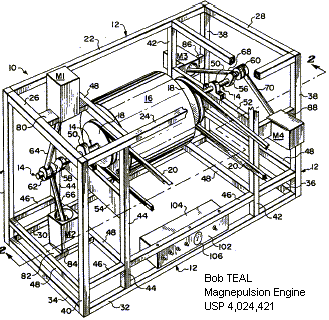
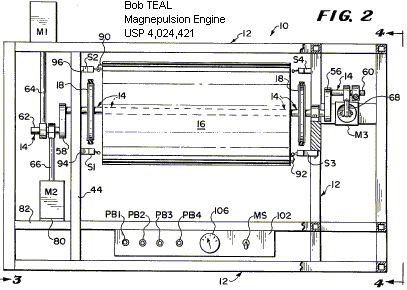

The present invention relates to a magnetically operable engine or power plant which, in a general way, functions in the manner of an internal combustion engine in that it employs a rotary crankshaft having offset cranks which derive their motion from power driven reciprocating members. Unlike a conventional combustion engine, the reciprocating members, instead of being motivated by the explosion of combustible gases in a combustion chamber, are caused to reciprocate by magnetic attraction, such members being in the form of cores or armatures which are associated with electromagnets, there being at least one magnet for each crank. Motivating current impulses are successively supplied to the various magnets by distributor means embodying respective normally open circuit making and breaking devices which are successively closed by one or more cams that rotate with the camshaft. The basic pronciple involved in thus applying toraue to the crankshaft may appropriately be referred to as ‘magnipulsion’ (a coined word) and such term may be employed where appropriate throughout this specification.
The present magnetically operable engine or power plant is capable of being used as a power source in connection with a wheeled automotive vehicle of either the passenger-carrying type or as a toy automobile. It is also capable of being as a fixedly mounted power plant for driving adjacent machinery of various sorts but, irrespective of the particular use to which the invention may be put, the essential features thereof are at all times preserved.
The provision of an engine which is extremely simple in its construction and which therefore may be manufactured at a low cost; one which is comprised of a minimum number of parts, particularly moving parts, and which therefore is unlikely to get out of order; one which is rugged and durable and which therefore will withstand rough usage; one which is smooth and silent in its operation; one which is capable of ease of assembly and disassembly for purposes of inspection of parts, replacement or repair thereof; and one which otherwise is well adapted to perform the services required of it are further desirable features which have been borne in mind in the production and development of the present invention.
The provision of an engine or power plant such as has briefly been outlined above, and possessing the stated advantages, constitutes the principal object of the invention. Numerous other objects and advantages of the invention, not at this time enumerated, will become readily apparent as the nature of the invention is better understood.
In the accompanying two sheets of drawings forming a part of this specification, one illustrative embodiment of the invention has been shown.
In this drawings:
FIG.1 is a perspective view of a magnetically operable power plant or engine embodying the principles of the present invention, portions of the framework or chassis being broken away in the interests of clarity;
FIG.2 is a sectional view taken substantially on the vertical plane indicated by the line 2-2 of FIG.1 and in the direction of the arrows;
FIG.3 is an end elevational view taken in the direction of the arrows associated with the line 3-3 of FIG.2; FIG.4 is an end elevational view taken in the direction of the arrows associated with the line 4-4 of FIG.2;
FIG.5 is an enlarged detail sectional view taken through one of the electromagnets and its associated connecting rod and crank which are employed in connection with the invention; and
FIG.6 is an electric circuit diagram of the power plant or engine.
Referring now to the drawings in detail, and in particular to FIGS. 1 and 2, a power plant or engine constructed according to the invention is designated in its entirety by the reference numeral 10 and it embodies in its general organization a chassis or framework 12 which serves to rotatably support an elongated crakshaft 14 on which there is mounted a relatively massive flywheel 16 in the medial region thereof. A pair of pulleys 18 on opposite sides of the flywheel 16 have associated therewith respective drive belts 20 which may extend to a suitable transmission (not shown) in the case of a wheeled automotive vehicle, or to the input drive element in the case of a stationary equipment which is to be driven by the power plant.
The framework 12 is comprised of an upper rectangular frame having longitudinal frame members 22 and 24 and transverse frame members 26 and 28, and a lower rectangular frame having longitudinal frame members 30 and 32 and transverse frame members 34 and 36. The framework 12 further includes a pair of intermediates posts 40 and front and rear vertical intermediate posts 42 and 44 respectively. A series of longitudinal struts 46 and transverse struts 48 extend variously between the posts 38, 40, 42, and 44 and establish an intermediate rectangular frame a slight distance above the lower rectangular frame 30, 32, 34 and 36.
A pair of bearing assemblies 50 are supported upon transverse support bars 52 and 54 and serve to rotatably support the crankshaft 14. Such crankshaft is provided with crank arms 56 and 58 on opposite sides of the flywheel 16 and with offset cranks 60 and 62. The crank 62 is connected by means of connecting rods 64 and 66 to respective electromagnets M1 and M2 which are fixedly mounted on the framework 12, while the crank arm 60 is similarly connected by connecting rods 68 and 70 to respective electromagnets M3 and M4, all in a manner that will be made clear presently.
The various electromagnets M1, M2, M3 and M4, together with their associated connecting rods 64, 66, 68 and 70 are substantially identical and therefore a description of one of them will suffice for them all. Accordingly, the magnet M1 (see also FIG.5) embodies a mnagnet casing or shell 72 within which there is disposed a magnet winding 74. An armature or core 76 is slidably disposed within the casing 72 and is pivotally connected as indicated at 78 to the associated connecting rod 64. The remaining magnets M2, M3 and M4 are similarly connected to their associated connecting rods.
The magnet M1 is mounted in a vertical position upon an upper shelf member 80 while the magnet M2 is mounted in a slightly inclined position upon a lower shelf member 82. As best shown in FIGS. 1, 2 and 3, the magnet M2 is seataed upon a wedge-shaped base plate or block 84 which serves to misalign the axis of the magnet M2 from the axis of the magnet M1 by a small anlge for a purpose that will be made clear presently. The magnet M3 is mounted in a horizontal position by means of a support member 86 while the magnet M4 is similarly mounted in a substantially horizontal position by means of a support member 88, the axis of the magnet M4 being slightly misaligned with respect to the axis of the magnet M3 likewise for a purpose that will be set forth subsequently.
Referring now to FIGS. 2, 3 and 4, one end of the flywheel 16 carries a cam 90 which is designed for successive engagements with a pair of substantially diametrically opposed microswitches S1 and S2 which are carried at the ends of a pair of horizontal supporting bars 94 and 96 respectively. Similarly, the other end of the flywheel 16 carries a cam 92 which is designed for successive engagement with a pair of substantially horizontally opposed microswitches S3 and S4 which are carried at the ends of a pair of horizontal supporting bars 98 and 100 respectively. As will become more readily apparent when the operation of the herein described magnetically operable engine or power plant is set forth in connection with the circuit diagram of FIG.6, the arrangement of the various cams and microswitches is such that upon rotation of the crankshaft 14 and flywheel 16, the contacts associated with the microswitches S1, S2, S3 and S4 will become individually closed, successively and in the order named.
Considering now the operation of the herein described magnetically operable engine or power plant 10, and with reference to FIG.6, it will be assumed that initially the position of the crankshaft 14 is such that, as shown in FIG.3, energization of the magnet M1 will swing the crank 62 upwardly at such time as the cam 90 engages the microswitch S1. Closure of the C1 contacts associated with the switch S1 will establish a circuit leading from the negative side of the battery B, through the master switch MS, through leads 11, 13, magnet M1, leads 15, 17, 23 and 25, back to the positive side of the battery B. Energization of the magnet M1 will draw the core or armature 76 (FIG.5) into the shell 72 and thus place the connecting rod 64 under tension so as to pull the crank 62 upwardly, thereby placing the crankshaft under torque for motivating purposes.
At approximately 90deg. in the engine cycle, the cam 90 will engage the switch S3 and closure of the contacts C3 thereof will establish a circuit from the master switch MS through the lead 27, magnet M3, leads 29, 31, C3 contacts of the switch S3, and leads 33, 35 back to the battery B, thus applying torque to the crankshaft 14 by placing the connecting rod 68 under tension.
At approximately 180deg. in the engine cycle, the cam 90 will engage the switch S2 and closure of the C2 contacts thereof will establish a circuit from the master switch MS through leads 11, 37, magnet M2, leads 39, 41, contacts C2 of the switch S2, and leads 43, 23, 25 back to the battery B, thus applying torque to the crankshaft 14 by placing the connecting rod 66 under tension.
At approximately 270deg. in the engine cycle, the cam 92 will engage the switch S4 and closure of the contacts C4 thereof will establish a circuit from the master switch MS, through lead 47, magnet M4, lead 49, C4 contacts of the switch S4, and leads 51, 43, 23, 25 back to the battery B, thus placing the connecting rod 70 under tension and applying torque to the crankshaft 14. The cycle is repetitious.
As shown in FIGS. 1 and 2, a control panel 102 is associated with a container or box 104 for the battery B and such panel may be provided with the aforementioned master switch MS and an indicator 106 which may disclose the amperage of current flowing from the battery B. Four push button switches PB1, PB2, PB3 and PB4 may also be provided on the control panel 102 and, as shown in FIG.6, such push button switches are arranged so that they operate upon closure thereof to establish shunts across the respective microswitches S1, S2, S3 and S4 so that an initial momentary closure of a selected push button switch on a trial and error basis may cause torque to be applied to one or the other cranks 60 or 62 for initial application of torque to the crankshaft 14 in the event that neither crank is in a favorable position for engine starting at the time that the master switch MS is initially closed.
It is to be noted at this point that although the cams90 and 92 are disclosed in FIG.2 as being disposed at approximately 180 deg. from each other on the flywheel 16, such cams appear in FIG.6 as being 90 deg. apart. It should be understood however that the disclosure of FIG.6 is purely schematic and is intended to illustrate only the sequence of operation of the four switches S1, S2, S3 and S4 under the control of the cams 90 and 92 and that the front and rear end faces 16F and 16R shown in FIG.6 rotate in the same direction since they do not represent front and rear end faces in the sense that they are illustrated in FIGS. 3 and 4. In other words, FIG.6 is predicated solely upon the sequence of microswitch operation and does not represent a true positioning of parts such as is disclosed in FIGS. 1 to 4 inclusive. It is also to be noted that by reason of the slight axial misalignment of the magnets M1 and M2, and of the magnets M3 and M4, continuous crankshaft movement is effected since at no time will the engine or power plant 10 attain a position of dead-center where closure of the master switch crankshaft 14.
The invention is not to be limited to the exact arrangement of parts shown in the accompanying drawings or described in this specification as various changes in the details of construction may be resorted to without departing from the spirit of the invention. For example, the precise placement of the various cams 90 and 92 and microswitches S1, S2, S3 and S4 on the flywheel 16 and framework 12 may be varied if desired as regards their angular relationship with respect to one another, the only criteria being the attainment of sequential operation of the switches in such a manner that torque is applied to the crankshaft 14 at all times by at least one of the four connecting rods. Furthermore, if desired a greater or lesser number of electromagnets suitably mounted on the framework 12, together with a commensurate modification of the nature of the crankshaft 14, may be resorted to if deemed appropriate. Therefore, only insofar as the invention has particularly been pointed out in the accompanying claims is the same to be limited.
I claim:
1 – A magnetically operated power plant comprising a work frame, an axially extended crank shaft rotatably mounted on said frame, a pair of spaced bearings one on each side of the frame for supporting a crank shaft, a fly wheel mounted on the crank shaft between the said spaced bearings, a crank arm fixed to each end of the crank shaft adjacent the said bearings and substantially 180 deg. apart and on the opposite side of the bearings from the flywheel, a pair of spaced hollow electromagnets positioned substancially diametrically opposite each other at each side of the frame and in substantially the same plane with the crank arm and perpendicular to the axis of the crank shaft, an armature for each electro-magnet adapted to slide within each of the hollow electro-magnets, a connecting rod for each armature having one end pivotally connected to the armature and the opposite end connected to one of the crank arms, an electric current for timely energizing the elctro-magnets when the armature is substantially adjacent one end of the electro-magnet, a timing means comprising a micro-switch for each electro-magnet, a timing means comprising a micro-switch for each electro-magnet fixedly mounted on said frame work, each switch including a pair of normally open contacts and disposed in series relation with said electro-magnet, said switch being disposed in circumferential spaced relationship about the crank shaft, means carried aat each end of the fly-wheel for closing each of the said switchies progressively on alternate sides of the frame to the respective electro-magnets in the direction of the operated crank shaft substantially at the time the solenoid is at one end of the electro-magnet, the electro-magnets of each pair having their axes slightly inclined at an angle to each other whereby the associated crank arms are minimized.
2 – A magnetically operated power plant as set forth in claim 1 wherein there is provided a push button switch for each electro-magnet and is effective upon depression thereof to shunt the contacts of its associated switch for moving the said crank shaft off center.
End of patent.
## USP 4,093,880, June 06, 1978, Magnetically Operable Engine, Benjiman R. Teal transcription by MDG nov07, from : http://www.free-energy.ws/pdf/Teal4093880.pdf
# References Cited:
– USP 2,056,719 – 10/1936 – Gelnaw … 310/35X
– USP 2,570,766 – 10/1951 – Chenault … 310/35
– USP 2,588,753 – 3/1952 – Norton … 310/35
– USP 2,639,544 – 5/1953 – Coffin … 310/24X
– USP 3,832,608 – 8/1974 – Mills … 310/24X
– USP 4,019,103 – 4/1977 – Davis et al. … 310/24X
# Abstract: A combination device for developing a mechanical output from electrical magnet solenoid, and preferably a plurality of same, together with an associated timing mechanism for actively controlling the time and degree of energization of said electrical magnet(s). Preferably at least one of the electrical magnetic solenoid structures may be provided with an air compressor structure for increasing the normal atmospheric pressure to a desired pressure.
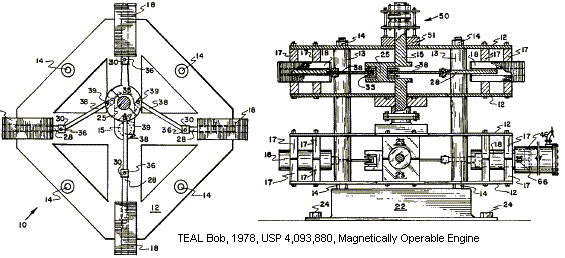
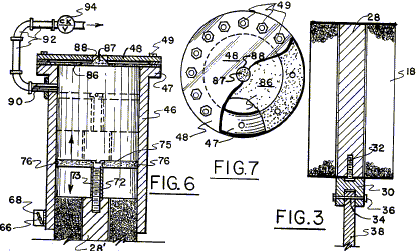
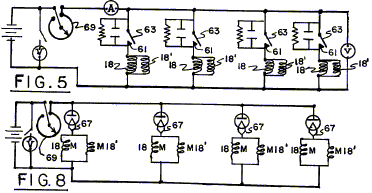
# Background of the invention:
1 – Field of the invention: This invention relates generally to devices changing electrical energy into mechanical energy in a form which maybe used to power useful work applications.
2 – Description of the prior art: A common problem with known type devices for converting electrical energy into mechanical energy is that they often times are very inefficient and waste a lot of energy in the conversion process. This is a great disadvantage in today’s age when conservation of energy is extremely important.
Another problem with known type engines utilizing electrical magnets for part of their structure is that the associated slidable solenoid mechanism is normally used just for converting the electrical energy into mechanical drive output without any direct actuation of useful work structure directly from the movable solenoid armature.
# Summary of the invention: An object of the present invention is to provide an electrical magnetic operated power engine for converting electrical energy into useful mechanical energy.
Another object of the present invention is to provide a magnet powered engine having a plurality of electromagnetic solenoids with electrical coils and movable solenoid armatures therewithin arranged in substantially the same plane and connected with associated mechanical transfer mechanism to convert the movement of the electric solenoid armatures into the desired mechanical power. A suitable timer structure is also associated with this mechanical structure for controlling the time and degree of energization of the respective electric-magnet coils for the various electro-magnetic solenoids.
A further object of the present invention is to provide an electro-magnetic solenoid engine structure which incorporates and has combined therewith a mechanical structure for compressing air at atmospheric pressure to a greater pressure for direct conversion of the electrical source power into a useful product.
An additional further object is to provide an electromagnetic type engine which includes a plurality of electromagnetic coils in associated timing structure arranged in substantially the same plane, with two or more of these structures being stacked one upon the other in order to greatly increase the overall output of the entire structure.
The magnet power engine and air compressor combination of this invention has a number of new and unique features not known or used before. A basic support structure is provided having at least one bank of electromagnetic solenoids arranged in substantially the same plane thereon. Each electromagnetic solenoid has a slidable and movable solenoid armature therewithin which is mechanically operated and connected to associated mechanical structure for converting the slidable movement thereof into a rotary shaft power output. A timing mechanism is also associated with this mechanical structure for appropriately connecting the electrical power source to at least one electromagnetic coil, and preferably a pluraity of same, so that they will operate in proper timing for directing the slidable movement of the solenoid armature back anf forth within the solenoid electro magnetic coil.
Also preferably combined with the aforesaid structure is an attachable cylindrical sleeve structure having a slidable piston therewithin and appropriate air valves for connection with the slidable solenoid armature so that useful work may be direclty accomplished such as by compressing atmospheric air to a much higher desired pressure. This structure may be provided for each of the electro-magnetic solenoids, or on less than all of same.
These together with other objects and advantages which will become subsequently apparent, reside in the details of construction and operation as more fully hereinafter described and claimed, reference being had to the accompanying drawings forming a part hereof, wherein like numerals refer to like parts throughout.
# Brief description of the drawings:
FIG.1 is a top plan view of the device of this invention.
FIG.2 is a side elevational view of this invention.
FIG.3 is a cross-sectional view of an individual electro-magnetic unit for the motor of this invention.
FIG.4 is an enlarged cross-sectional view of the timing switch mechanism for the motor of this invention.
FIG.5 is a schematic diagram of the electrical hookup for a four unit single bank of the motor of this invention.
FIG.6 is a cross-section of a single solenoid engine unit with air compressor attachment.
FIG.7 is a top plan view of the air compressor head end of FIG.6.
FIG.8 is a schematic diagram of an alternate electronic electrical hookup for the motor.
# Description of the preferred embodiment: Looking at FIG.1 of the drawings, reference numeral 10 indicates one bank of the electro-magnet motor of this invention. Looking at FIG.2, two banks, one being stacked on top of the other may be seen.
Each bank basically is provided with a support structure 12 approximately square in shape with two of said support squares being provided for each engine bank. Appropriate spaces separate these support squares and together with nuts and bolts 14 from the basic supportfor each engine bank. As may be best seen in FIG.2 the lower must bank is supported from any desired support surface by means of another support structure 22 with appropriate bolts 24. Support brackets 17 appropriately mounted on the respective squares 12 support the respective electro-magnet coils 18 therebetween. As seen in FIG.1, this bank is provided with four electro-magnets appropriately spaced at the four corners of the square support frame. It has been discovered in actual practice that a bank of four electro-magnets works extremely well and provides a fairly balanced power output. Each electro-magnet coil 18 is provided with a suitable number of coil windings to effect the slidable movement of a centrally mounted solenoid armature 28 therewithin.
As best seen in FIG.3, the one end of the solenoid armature 28 is appropriately center tapped for reception of a threaated screw 32 therewithin. This threated screw 32 appropriately secures a block of aluminum or other non magnetic material 30 to this end of the armature. The block 30 forms a connecting link through suitable apertures provided therewithin and by means of a connection of a pin 34 with locknut 36 thereon to a connecting rod portion 38. This connecting rod 38 is suitably pivoted at 39 to the disc 35 which is mounted so as to transfer power to the connecting rod crank 25. The connecting rod crank 25 is suitably formed at appropriate points along a crank-shaft 15 as best seen in FIG.2. If only a single engine bank is to be used just a single crank-shaft throw 25 is necessary, but for an engine having two engine banks as seen in FIG.2, two such throws are required and as the number of banks increases, the corresponding number of crankshaft throws is necessitated.
In operation as the electromagnets are energized in proper sequence, the electrical input will be transformed into mechanical output through the afore described mechanism. In order to assure that the electromagnets are operated in proper time relationship a timing mechanism is also provided. Such timing mechanism is indicated in general by reference numberal 50 in FIG.2, and shown in enlarged detail in the cross-sectional view of FIG.4.
A mechanical coupling unit 51 appropriately supports the timing mechanism at one end of the electromagnet motor and by means of appropriately threaded bolts 54 support plates 52 therefrom. The plates 52 are spaced from each other and each supports thereupon insulator blocks 58. These blocks support electric connectors 56 which in turn connect with bias springs 57 and electrical brushes 61. The insulating blocks 58 are fixed upon the supports 52 and are non-rotatable, but the center disc 59 supported therebetween is mounted for driven connection from the end of the crankshaft 15. Each side of the rotatable disc 59 is provided with conducting segments 63 which are internally connected to each other so that the electrical energy connected to input contacts 56 on the upper side of the timing mechanism may be appropriately transferred through springs 57, brushes 61 through the segment 63 to the lower brushes 61, springs 57′ and contacts 56′ which are appropriately connected to the respective electromagnets of the engine. Of course the segment 63, 63′ are appropriately designed for the number of electro-magnets of the engine. Of course the segment 63, 63′ are appropriately designed for the number of electromagnets used for the respective banks as well as the total number of such banks and are connected by appropriate wiring, not shown, in such a manner that each electromagnet will be energized for substantially the full stroke of its slidable solenoid armature and thus transfer the maximum of energy from electrical form to mechanical from.
FIG.5 shows an electrical schematic with one of the electromagnet solenoids having coils 18 and 18′ indicated and with contact brushes 61 and timing segment 63 indicated schematically. Also shown across the timing contact 61, 63 are resisters and capacitors in parallel. The purpose of this is to minimize arcing of the make and break contacts of the respective brushes and contact segments.
FIG.8 shows an alternative form of energizing the electromagnet solenoids which is generally referred to as a solid-state switching and which is actually performed by diodes 67. The current entering the solenoids may be regulated by the rheostates 69 as shown in FIGS.5 and 8.
Looking at FIG.2 on the right side thereof, an air compressor sleeve 46 is shown appropriately secured by clamp means 66 to one of the electromagnet structures.
FIG.6 shows this structure in enlarged detail. The outer end of the solenoid armature 28′ is appropriately tapped for reception of a threded bolt 72 therewithin. The enlarged head of the threaded bolt together with a spacer sleeve 73 appropriately support a flat piston member 75. This piston member 75 may be appropriately provided with a compression ring 76 of conventional type. The clamp structure 66 to secure the sleeve 46 at the end of the electromagnet is preferably provided with a thumb nut 68 or the like to secure same. The other end of the sleeve 46 has an outstanding flange periphery 47 for suitably securing a cylinder head 48 thereto. Appropriate bolts and nuts 49 together with suitable gaskets form an air-tight seal between the head 48 and the sleeve 46, 47. For proper compressing operation to be effected, it is necessary that suitable valve mechanism be associated with this compressor structure. This is in the form of a flexible diaphragm 86 which is secured around the circumference thereof between the head 48 and the flange bracket 47. At the center of the flexible diaphragm 86 is mounted a cone shaped protusion 87 which together with an aperture 88 provided in the center of the head 48 functions as a one way intake air valve. That is, when the piston 75 is moving away from the head and the diaphragm, air will be drawn into the inside of the cylinder sleeve 46 through the aperture 88, and then in turn on the compression stroke of the head 75 thr protursion 87 will seal aperture 88 and then the escape of air out this opening will be prevented. Another outlet 90 appropriately connected by tubing 92 to a one way check valve 94 provides an outlet for the compressed air and yet prevents backflow thereof. All or some of the connecting tubing 92 may be of a flexible nature as desired.
As can be readily envisioned, when one or a plurality of the electromagnets are provided with such air compressor sleeves, a direct useful engine output in the form of air under high pressure is achieved. As so constructed, the entire apparatus may be used solely for providing compressed air for various useful purposes. However, by connecting suitable work apparatus to the output of crankshaft 15, near the timing mechanism 50, other devices may be driven from this electromagnet structure.
The foregoing is considered as illustrative only of the principles of the invention. Further, since numerous modifications and changes will readily occur to those skilled in the art, it is not desired to limit the invention to the exact construction and operation shown and described, and accordingly all suitable modifications and equivalents may be resorted to, falling within the scope of the invention.
I claim:
1 – An engine combination comprising a plurality of electromagnetic coil means for operating a like number of solenoids for converting electricity to mechanical power, a first separate bank of of electromagnetic coils and solenoids arranged about a single crank shaft and mounted upon a supporting plate to form a single power unit, and a base for supporting said first electric power unit and at least a second set of electromagnetic coils and solenoids arranged about a second single crank shaft and mounted upon a second single plate to form a second single power unit positioned above said first power unit, and means for connecting one end of the crank shaft of the first power unit to one end of the crankshaft of the second power unit, a single timing mechanism arranged to connect all of the said electromagnetic coils in proper synchronization with each of the said power units, each of the power unit supporting units having means extending upwardly from the base for supporting the said plates supporting each of the power units, and means for connecting the said coils in each bank with a source of electric energy.
2 – A structure as claimed in claim 1 wherein a single timing unit having an armature is mounted adjacent the upper end of the crank shaft of the upper bank of electromagnetic coils and solenoids and connected to all the coils of the electromagnets at the proper points in relationship to the position of the single solenoid armature.
3 – In a structure as claimed in claim 1 including an attachable and removable cylindrical sleeve for at least one of said electromagnets having a gas compressor means in the form of a reciprocating piston, said piston having means for connecting the same to the solenoid armature for operating said compressor piston, the outer end of said sleeve having an intake valve in the form of a diaphragm.
End of patent.